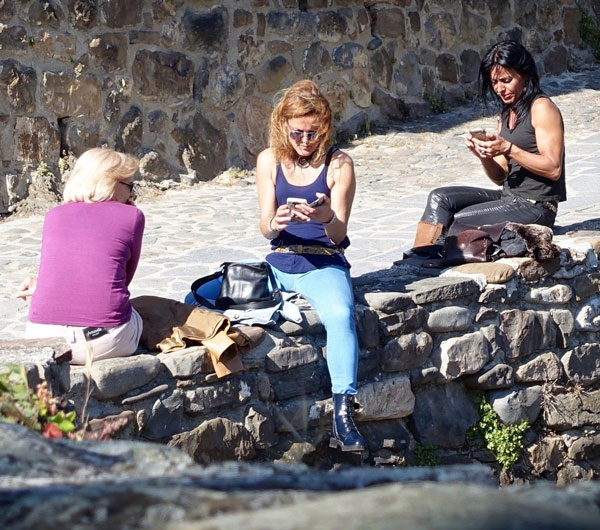Enough with Phubbing Already: Cell Phones and the Loneliness Epidemic

These days it’s a common sight to see a group of teenagers out for a fun time together. Except they don’t seem to be having much fun, nor are they exactly together—at least they’re not talking to each other. Each is bent in worship fashion over his or her cell phone.
I’m reluctant to comment on this for fear of sounding like my Aunt Evelyn, who used to say (rather loudly) that when SHE was young, couples went roller skating and dancing and did all kinds of fun things together, not just going out for pizza like my generation of young people were doing.
In other words, how do we know that today’s teens aren’t having just as much fun as we did, only the technology and customs have changed?
Except we do know. A slew of recent research tells us that depression and loneliness are skyrocketing in teen populations, especially girls. And according to researchers, the spike in isolation is highly correlated with the advent of cell phones and social media.
It’s happening in adult populations as well. Former US Surgeon General Vivek H. Murthy recently wrote about our nation’s “loneliness epidemic” in the Harvard Business Review: “We live in the most technologically connected age in the history of civilization, yet rates of loneliness have doubled since the 1980s.”
He goes on to point out that loneliness is associated with reduction in lifespan (similar to that caused by smoking 15 cigarettes a day, and more than the impact of obesity). Loneliness is also associated with a greater risk of heart disease, depression, anxiety and dementia, plus a reduction in creativity, task performance and decision-making on the job.
So while we may be connected with thousands of people on Facebook, we are increasingly feeling isolated from the people right in front of us. In fact, there’s now a word for cell phone usage in a social situation: phubbing. It’s a combination of “phone” and “snubbing,” and we all know how that feels—to be sharing your heart-wrenching story and suddenly all you’re seeing is the top of the other person’s head as they bend to the will of their cell phone (and you suddenly realize that somebody else is more important to them than you are).
The irony is that we turn to cell phones and social media to feel more connected with others, but somehow they have only made the isolation and loneliness in our society worse.
Searching for Solutions
So what are we, as adults, to do? Ban the teens in our lives from using cell phones? Not likely. Stop using cell phones ourselves? Even less likely. For most of us, cell phone technology is essential for us to manage our jobs, travel, household, families—and is actually, at its best, a great way for parents and teens to keep in touch.
One practical way to approach the problem is to manage your cell phone use—for instance, simply putting away your phone when on dates, at family meals, or having an intimate conversation with your friends or spouse. This means not only turning it off so you can’t be interrupted, but also physically placing it out of view in your purse or in another room.
Why? In recent research, subjects reported that even the presence of a phone can interfere with personal relationships—having negative effects on closeness, connection, and conversation quality. Subjects said this was especially true when discussing personally meaningful topics. (And women find phubbing much more distracting in personal settings and in the classroom than men do, according to research.)
But somehow I think we have to go beyond good cell phone etiquette to address our society’s deeper issues of isolation and loneliness, which are enhanced not only by new technologies, but by demands of long work weeks, the requirement to be “on” 24/7, and the intense pace of life these days.
Finding Connection Within
Loneliness is a state of mind, not the physical state of “being alone.” It’s about feeling lack of connection with others, and we can feel more isolated and lonely in a crowd than when alone.
Yet when we talk about connecting with others, we are ultimately talking about connecting with ourselves. When we’re feeling rested, calm, and happy, it’s much easier to feel a sense of connection with our family, friends, and literally anyone we meet. When we are more awake to our best, most loving selves, we naturally become more awake to the love and joy that is right in front of us. As Anais Nin said so aptly, “We don’t see the world as it is, we see it as we are.”
Many women are find that practicing the Transcendental Meditation (TM) technique is the most effective way to stay “connected.” In this sense the connection is between the different layers of our personality—from outermost behavior and sensory perception to our innermost level of Being.
Through TM practice, we transcend everyday thoughts and experience the silent state of happiness, energy, love, and strength that resides deep within us, but is difficult to access in the rush of daily living.
Research shows that this experience of transcending, just 20 minutes twice a day, has a powerful effect on physical health, emotional well-being, and social relationships. Practitioners report deeper, more satisfying connections with others—whether it’s between student and teacher, co-workers or family members.
How does this work? We all know that any relationship becomes more difficult when we’re tired and stressed. TM is considered to be the most effective way to dissolve deep-rooted stresses, including those caused by trauma and PTSD, according to research. And because stress is the cause of most disease and emotional imbalance, lifting the load of stress off the mind and body has a powerful effect on your entire life.
The most effective solution to isolation and loneliness, then, is to create a state of awareness that is never disconnected from your deepest, best self, from the unbounded field of love and connection within you.
And when we are feeling more connected to our inner source of calm and happiness, we naturally radiate that to others, contributing to their feelings of well-being and connectedness as well.
This is how we can strengthen the bonds of real togetherness. To be so grounded in our own inner happiness that we naturally look up to meet the eye of the person we’re talking to—the people we live with, the people who we love—to check in with them and empathize with whatever they are feeling.
In other words, using our cell phones in a balanced way is a result of being established in a state of inner balance that naturally is expressed in the small—but incredibly important—moments of our lives.
About the Author
Linda Egenes writes about green and healthy living and is the author of six books, including The Ramayana: A New Retelling of Valmiki’s Ancient Epic—Complete and Comprehensive, co-authored with Kumuda Reddy, M.D.
More Posts by Linda
- Tired and Burned Out? Transcendental Meditation Can Help: An Interview with Dr. Nancy Lonsdorf, MD
- Worried About the Future? Six Ways to Calm Your Anxiety
- What Do You Carry in Your Self-Care Tool Kit?
- Five Strategies for Family Caregivers
- From the Streets to College in Four Months: The Communiversity of South Africa Empowers Underserved Youth in Cape Town





